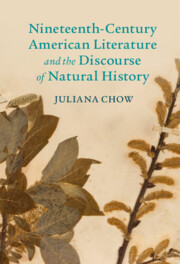Book contents
- Nineteenth-Century American Literature and the Discourse of Natural History
- Cambridge Studies in American Literature and Culture
- Nineteenth-Century American Literature and the Discourse of Natural History
- Copyright page
- Contents
- Figures
- Acknowledgments
- Introduction
- Chapter 1 Sketching American Species: Birds, Weeds, and Trees in Audubon, Cooper, and Pokagon
- Chapter 2 “Because I see—New Englandly—”: Emily Dickinson and the Specificity of Disjunction
- Chapter 3 Coral of Life: James McCune Smith and the Diasporic Structure of Racial Uplift
- Chapter 4 Thoreau’s Dispersion: Writing a Natural History of Casualties
- Afterword: &
- Notes
- Index
- Recent Books in This Series (continued from page ii)
Chapter 2 - “Because I see—New Englandly—”: Emily Dickinson and the Specificity of Disjunction
Published online by Cambridge University Press: 16 November 2021
- Nineteenth-Century American Literature and the Discourse of Natural History
- Cambridge Studies in American Literature and Culture
- Nineteenth-Century American Literature and the Discourse of Natural History
- Copyright page
- Contents
- Figures
- Acknowledgments
- Introduction
- Chapter 1 Sketching American Species: Birds, Weeds, and Trees in Audubon, Cooper, and Pokagon
- Chapter 2 “Because I see—New Englandly—”: Emily Dickinson and the Specificity of Disjunction
- Chapter 3 Coral of Life: James McCune Smith and the Diasporic Structure of Racial Uplift
- Chapter 4 Thoreau’s Dispersion: Writing a Natural History of Casualties
- Afterword: &
- Notes
- Index
- Recent Books in This Series (continued from page ii)
Summary
This chapter takes Dickinson as its first case study to examine how figures such as a robin or a pine can map out partial ecological relations that allow for survival. As her poetic and scientific engagement shows, understanding species as figures reveals both their material and speculative potential—what is termed their disjunct specificity since a literary figure can be understood to have both a material or literal ground and a metaphorical meaning. As figures, species are partially empirical matter (as the successive biological reproduction of individuals) and partially subjective concepts (as idealized or defined “types”). The chapter first examines the scientific problem that disjunct species presented, where similar species appeared in widely disparate geographical regions, prompting investigations by scientists such as Asa Gray and Louis Agassiz about whether or how these species could be biologically and spatially related. Moving from their observations to Dickinson’s poetic-empirical observations, the partiality of her gaze reveals a sense of species engaged with current discussions of biological species, but also significantly more diminutive. This “species” reveals ecological relation to be figural and partial, based upon a certain slippage between some material that holds while the earth, sky, and even body shifts, departs, disperses.
Keywords
- Type
- Chapter
- Information
- Publisher: Cambridge University PressPrint publication year: 2021



